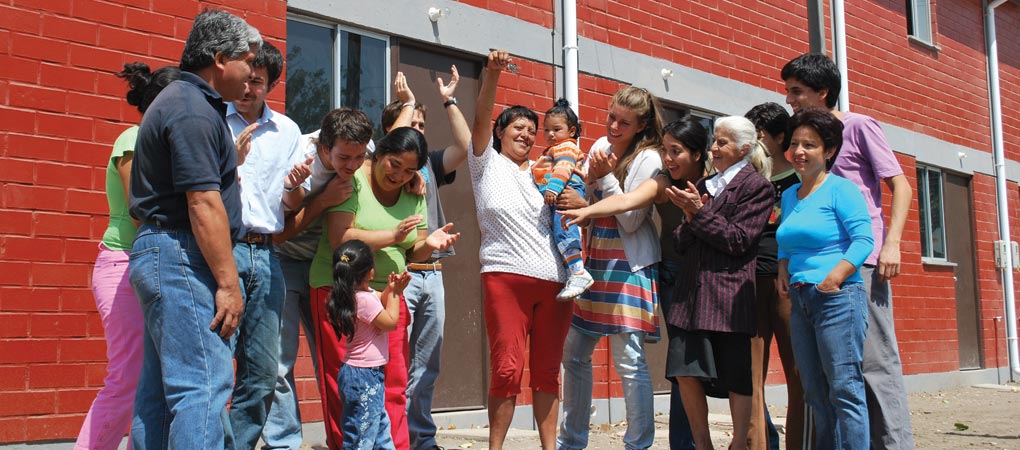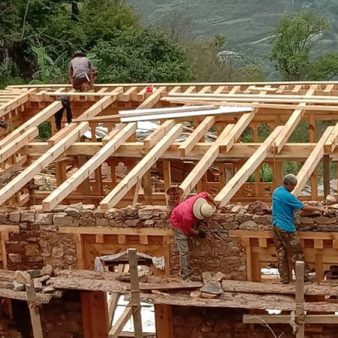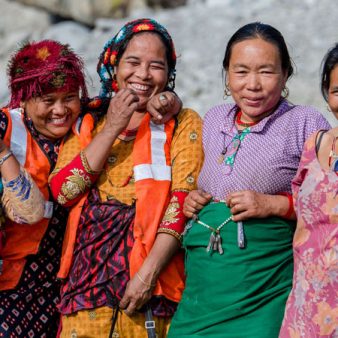Un Techo para Chile (UTPCH) is an NGO founded in 1997 in Chile by a group of university students and a Jesuit priest, Felipe Berríos S.J., who were appalled by the country’s deplorable slum conditions and felt compelled to take an active role in addressing them. The initial work involved students helping slum dwellers build small wooden transitional houses to meet their immediate shelter needs. Having scaled up this activity nationally, social inclusion programmes were established as a second stage of activity, with the volunteers helping the slum dwellers improve their economic position. A third phase is currently underway with the provision of permanent accommodation. The main beneficiaries are 10,000 families (about 45,000 people) who will obtain permanent housing, along with the thousands of young volunteers whose understanding of poverty and inequality has been increased.
Project Description
Aims and Objectives
The main objective of UTPCH is to help overcome poverty through the work of youth volunteers and the involvement of public and private institutions. The specific objective of the ‘From Slum to Neighbourhood’ programme is to deliver permanent homes to 10,000 families currently living in slums by September 2013.
Context
According to UTPCH, approximately 20,000 families currently live in 533 slums throughout the country. These settlements not only lack decent housing and access to basic services, but also suffer from a lack of access to health care, education and employment opportunities. The houses in these slums are self-built with discarded materials such as wood, cardboard, mesh, zinc, etc. and there are high levels of unemployment, alcoholism, drug abuse, domestic violence and prostitution in the slum areas. A further 380,000 low income families live in poverty in irregular housing situations.
Although successive government housing policies have successfully alleviated the housing deficit, the focus has been on quantity rather than quality and many of the new houses have been provided on the periphery of cities. This has led to a marked social segregation, with large urban areas characterised by a lack of infrastructure, disintegration of social networks, separation of families from their relatives, jobs, friends, and from their old residential zones.
Key features
This project will provide 10,000 new build permanent homes for slum-dwellers in Chile. UTPCH sees this as the third stage of its work, building on its earlier provision of transitional housing (no longer continued in Chile) and social inclusion programmes, which provide education and training in healthcare, income generation, micro-finance, trade skills, legal aid and cultural / recreational areas. Volunteers are the essence of the projects as they are not only directly involved but leading social inclusion programmes. During the last earthquake, more than 23,000 transitory homes were constructed in less than three months.
The project takes place as part of a national housing policy, with government funding of US$23,000 per household available. These projects can be delivered by any of Chile’s registered social housing providers, although UTPCH seeks to improve upon the basic model. It does this by continuing to run its social inclusion programmes to address the levels of poverty, by providing a higher quality house and better integration into their new neighbourhoods for those residents who relocate. Families have to be organised in groups of 50 to be able to apply for the subsidy. All the families involved have been provided with a transitional house by UTPCH.
UTPCH helps the families identify suitable and well-located plots of land, develop designs for the housing and neighbourhoods, hire and supervise the construction teams, emphasising the importance of participation throughout. The new apartments are typically arranged in two- or three-storey blocks, are built of bricks and mortar and range in size from 42m2 – 65m2. Where possible the existing land being informally occupied is purchased from the landowner to build the new apartments, but this is increasingly difficult with lengthy legal processes and rapidly increasing land prices.
Ninety-eight per cent of households stay within their own neighbourhood, with relocations rarely more than 1.5 km from their original home. Fifteen per cent of households are able to stay on the same site. With increasing pressures on land the number of storeys is expected to increase to five or six. Ownership is given to the families. To date 8,019 families are involved in 104 different projects and a total of 616 out of the 10,000 houses have been completed.
Covering costs
As an approved social housing provider, UTPCH receives subsidies from the Ministry of Housing and Urbanism’s Single Housing Fund worth approximately US$23,000 per family for the purchase of land, provision of infrastructure and the construction of a permanent housing unit. In addition, a development allowance of US$670 per apartment is paid to UTPCH for its administration and development work, i.e. a total of US$6.7m for 10,000 families.
To be entitled to a housing subsidy from the Single Housing Fund, families are required to save US$400, but UTPCH requires that they save an additional US$400 in order to be able to improve the quality of the house and to encourage a savings habit. These funds are used to improve on the quality of the standard house or to help pay for high-priced land.
Five private sector multinational companies provide support to the tune of US$13.8m and further sources of private funds are being sought, hoping to raise US$50m. These funds support the social inclusion programmes and provide some extra towards the government subsidy of US$23,000 per apartment to improve on the basic standard.
Finally, there are also various street fundraising initiatives, carried out by thousands of volunteers. As well as requesting donations, volunteers raise public awareness of housing problems and UTPCH’s work.
Impact
This project has already delivered more than 70 hectares of urban land to slum dwellers and will have provided 10,000 families with a permanent home by 2013. Families who used to live in slums now live in neighbourhoods that are integrated with formal services and networks.
Whilst UTPCH does not claim to be the only organisation to have developed this non-paternalist type of intervention in Chile, it has gone further, by publicising and critiquing social policies. The new housing policy has finally, after many years, shifted towards good quality public housing, including the opinions of the residents in the design, construction and choice of location of their apartments. Twelve years ago when UTPCH started working in slums, these ideas were not established in public policy debates and practices. Today, addressing the issue of city slums is one of the current government’s priorities, and is even a core theme in the manifestos of Presidential candidates.
Why is it innovative?
- Bringing together divided sectors of society, by taking young professionals and university students, often from affluent backgrounds, to the most impoverished slums, thereby opening their eyes to the harsh realities of poverty.
- Focusing on comprehensive development rather than simply overcoming material poverty.
- Financial support from businesses, which promotes the development of social responsibility in the commercial sector.
- Creation of sustainable neighbourhoods, avoiding a traumatic transition from the slum to the bricks and mortar house.
- Improved public housing standards, with easily constructed, affordable and safe extensions, high insulation and safety.
- Architects have started seeing public housing as a challenge and not as an undesirable job.
- Development of innovative tools such as Geographical Information Systems and satellite photo-interpretation to locate unoccupied plots of land.
- Community participation including a participatory design methodology, with residents working together with the architects, designers and professionals from UTPCH.
What is the environmental impact?
- While the transitional homes are very simple and are made of quickly assembled wooden panels, the permanent apartments are typical bricks and mortar construction.
- The low budgets of public housing projects generally do not include sufficient resources to exceed the minimum energy saving standards. However, by obtaining extra funding from government and NGOs, energy saving components have been included in some projects. For example, the ‘Together We Can’ housing project has solar panels that supply 125 families with hot water.
- The environmental quality of city life has increased through helping create better-planned and more efficient cities, limiting urban sprawl.
Is it financially sustainable?
- The project relies largely on public housing subsidy and UTPCH sees it as an achievement that the government has accepted its responsibility to provide public housing for those on low incomes.
- In addition to the training provided to households by UTPCH, studies show that for every housing unit constructed, 1.6 jobs are created. Where possible, the contractors are encouraged to take on skilled residents to help create the possibility of new income sources for the community.
- Encouraging a savings habit amongst households brings long term benefits for them.
- UTPCH helps families access the government housing grant, as well as some additional finance from private companies. The grant does not need to be repaid and UTPCH does not charge a fee to the families, as other registered social housing providers do, and claims to have a more supportive relationship with the families. UTPCH say that the US$800 that it requires from each household is affordable to most and for those who cannot pay, the funds are raised through fundraising events which the students help organise. The units cannot be sold for five years, but can be sublet. If new land has been purchased, the timeframe is extended to 15 years.
What is the social impact?
- Families work together in groups of at least 50, applying for the grant and developing their new homes. If they are relocated, they are encouraged to work together with their new neighbours to ensure good cooperation in the community.
- Training is provided through the social inclusion programmes, a crucial part of which relates to money management and the encouragement of a savings habit. The courses focus on a range of hard and soft skills and develop responsibility, punctuality, problem solving etc. These programmes are led by community representatives who develop their own leadership skills.
- Improved living conditions and better information provided through the healthcare training programme ensure that people are healthier and safer.
- By ensuring that the new neighbourhoods and the residents are connected to the formal networks of the city, especially health, housing and education, social inequalities have been significantly reduced.
- Individual empowerment is a key element of all of UTPCH’s social inclusion programmes. In addition to the provision of primary education for all, these programmes include vocational training and entrepreneurship skills, along with raising awareness of financial management techniques. The Community Organising Meetings that form the core of UTPCH’s social inclusion programmes are essential to helping residents participate in civil society. Through these meetings residents begin to believe in themselves and in the strength of community organisation, empowering them to overcome their learned helplessness and participate in formal networks and democratic spaces.
Barriers
- In the beginning, it was difficult to convince people that UTPCH’s approach would work.
- Getting involved with the families living in the slum areas was difficult for some volunteers and UTPCH staff, requiring steps to be taken to overcome a series of prejudices deeply-rooted in Chilean society.
- The perception of being a wealthy country distracted society at large from the fact that high levels of poverty still exist.
- As an organisation composed of university students and young professionals with high levels of commitment and enthusiasm but with little working experience, there was little knowledge of how to deal with the real estate industry.
- It was a real challenge to find available and affordable plots of land for the apartment blocks.
- It was necessary to overcome the common belief that great architects should only work on the creation of grand buildings and not public housing. UTPCH convinced famous architects to design integrated neighbourhoods including public housing.
- Convincing construction companies to work for low profits was a very complicated challenge, but one that was accomplished thanks to the strong positioning of UTPCH and the perseverance of staff and volunteers.
- Young people did on occasion become frustrated with the slow bureaucratic rhythm of the public system.
Lessons Learned
- Offering basic, transitional housing is a necessary first step towards slum eradication, but it is insufficient for the eradication of extreme poverty. Social inclusion programmes and permanent and inclusive housing were necessary to develop sustainable communities and neighbourhoods.
- A capacity to listen is a crucial attribute in order to include the residents in every single stage of the process.
- In order to develop committed work from the volunteers, they must feel part of an institution where their opinions are listened to and considered.
- Working with low income people requires great professionalism, rather than the commonly held view that only a mediocre effort is required if low income people are involved.
- It is essential to communicate your work externally in order to raise the profile of your organisation’s cause.
- Handling the expectations of the beneficiaries is key, as the final result will not always be everything the beneficiaries are expecting. This is achieved by communicating constraints throughout the course of project, in order to avoid false expectations.
- Houses are not the total solution to all a family’s poverty, but rather only one step towards their development.
- The provision of public housing is a long and slow process, taking as it does anything from two to four years.
- Working with instead of for the family may be a lengthy process but it insures its sustainability.
Evaluation
- UTPCH’s Social Investigation Centre is currently evaluating results and perceptions of families who have recently moved to their neighbourhoods.
- It is also establishing baselines in those communities that are still living in slums in order to be able to evaluate the improvements in their quality of life, once living in the new neighbourhoods.
- Given the important role the families play in this process, they are constantly monitoring and evaluating the project. This formally takes place during the periodic meetings of the housing committees and/or in general assemblies where all the families participate.
Transfer
The work of UTPCH has grown rapidly since it started 1997 and now covers eight of the 13 regions in Chile as well as having a presence in 16 other LAC countries.
The number of projects in Chile has increased from six in 2005 to 104 in 2009.
The first stage of the project (construction of transitional houses) has been expanded to 16 other countries, of which seven countries have also developed the social inclusion programmes.
It is hoped that the third phase to provide permanent homes will soon be starting in Uruguay.
Over 250,000 volunteers have been mobilised in the 18 countries and over 70,000 transitional homes built to date.
The work in other countries is managed from the UTPCH headquarters in Santiago in Chile, rather than through autonomous units in the individual countries.
Partnership
Academic/research, Local community, National government, Local government, Private sector



